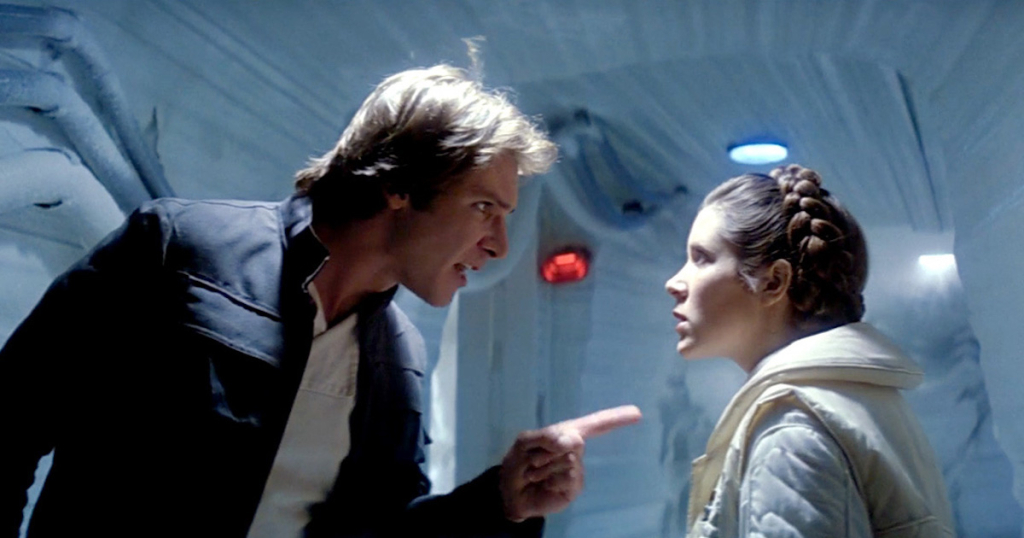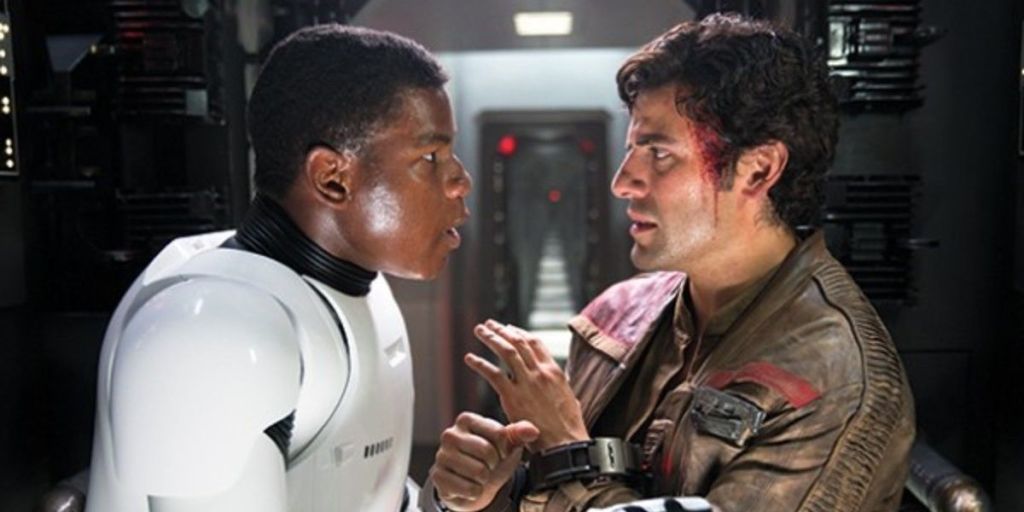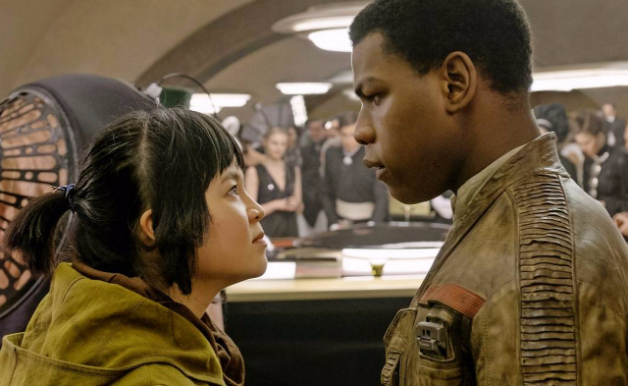THE LAST JEDI essentially opens up with a “yo mama” dis, as hotshot pilot Poe Dameron sets the tone for the rest of the film by taunting the villainous General Hux from the cockpit of his X-Wing. It’s a brilliantly funny sequence, and THE LAST JEDI carries a real wit throughout, with our heroes and villains always quick with a joke in a tough situation. Rian Johnson’s script attempts to bring a sharp sense of humor to the sometimes pretty heavy proceedings; when the jokes hit, they recall the best of Lawrence Kasdan, entertaining the audience and developing the characters. When the quips fall flat, they resemble something that was cut from an AVENGERS script or bad slapstick from the prequels; space opera is easy, but comedy is hard. The humor works more often than not and THE LAST JEDI is certainly swinging for the fences in terms of slapstick, gags, quips, jokes—much harder than any other film in the STAR WARS franchise. However, STAR WARS’ sense of humor has always been one of the series’ most impressive and powerful special effects.
George Lucas’ original script, THE ADVENTURES OF LUKE STARKILLER AS TAKEN FROM THE JOURNAL OF THE WHILLS, SAGA 1, STAR WARS was only funny in that its title was ridiculously long (although the kid resetting the marquee at the theater probably wouldn’t have been laughing). Producer Gary Kurtz called the script “gobbledygook”, and producer Alan Ladd straight-up admitted that “it [didn’t] make much sense” to him. Enter Willard Huyck and Gloria Katz.
Having previously worked with Lucas on an early treatment of AMERICAN GRAFFITI (which garnered them an Oscar nomination), the screenwriting duo was brought on to do what amounted to a “comedy polish” on Lucas’ fourth draft of the film.
“[Lucas] said ‘Polish it–write anything you want and then I’ll go over it and see what I need,” Katz told The Mary Sue earlier this year. “George didn’t want anyone to know we worked on the script,” Katz says—Fox was already nervous about STAR WARS and Lucas didn’t want the studio heads getting word that the script was being taken on by outside writers—“so we were in a cone of silence.”
One need only watch THX 1138—or even the STAR WARS prequels—to get the impression that, while a technically impressive director, visual stylist, and conceptualist, George Lucas never the class clown.
“We just tried to help with the characterization, to add as much humor as possible,” states Katz. “We didn’t want to take the credit away from him—he had been working on STAR WARS for a very long time.”
Much of the wit of STAR WARS is credited to Huyck and Katz, from the banter around the chess match (Katz’s favorite line from the film is “Let the wookie win.”), Luke chatting with Threepio in his Tatooine garage, Han’s attempt at staving off reinforcements in the Death Star’s detention center, and the wonderfully human bit where Han teases Luke about his crush on Leia.

Katz and Huyck also developed the character of Princess Leia who gets all the best lines during the Death Star escape. “When we talked to him about the character, we said Leia should be a more ‘Hawksian woman,’ with all the traits that that woman had: she can take command; she doesn’t take any shit,” Katz recalls. “At the same time she’s vulnerable and to write her as really focused, instead of just a beautiful woman that schlepped along to be saved.”
It’s long been debated how much of the script can be contributed to Huyck and Katz, but George Lucas has stated, “the scenes are mine, but the dialogue is theirs.”
While the cantina sequence state of the art special effects were the talk of the town upon its release in 1977, it was the sense of humor that truly endeared STAR WARS to audiences. Before STAR WARS, sci-fi was generally pretty stiff. STAR TREK was not without its humorous moments, but Gene Roddenberry was more concerned with storytelling and saving the world than cracking wise at the audience. STAR WARS featured a little bit of slapstick—mainly interactions with Artoo and Threepio— and rapid fire, HIS GIRL FRIDAY banter between Han, Luke, and Leia, made unfamiliar characters from a galaxy far, far, away relatable. (Very few people have bullseyed womprats in their T-16 or made the Kessel Run in less than 12 parsecs, but we’ve all had a friend rib us about a crush.) The entire Death Star escape is peppered with wonderfully funny lines that brings—as EMPIRE STRIKES BACK scribe Lawrence Kasdan would describe it, “delight” to the film. Audiences—and George Lucas—owe that debt to Huyck and Katz.

“That helped immensely,” Kurtz told Chris Taylor of Mashable. “That last draft before their influence was a little too serious.”

Kasdan came onto THE EMPIRE STRIKES BACK in 1978. Lucas had penned a rough draft of the script—Leigh Bracket is credited despite her draft being tossed out—and Kasdan was brought in to take it across the finish line. Kasdan brought his own brand of wit to the STAR WARS universe. Kasdan went on to pen SILVERADO, THE BIG CHILL, and another collaboration with Lucas, RAIDERS OF THE LOST ARK one need look no further than those film to get a sense of Kasdan’s brisk, tight style. No doubt it was Kasdan that amped up the Tracy and Hepburn screwball sensibility to the budding romance between Han Solo and Princess Leia for the 1980 sequel. While they’re not on screen together for the majority of the film, some of the most fun dialogue comes between Artoo and Threepio when they are reunited on Cloud City, Threepio scolding the astromech for “trusting a strange computer.” So much of this humor is based on human interaction, and with it coming from droids, it makes it just a touch subversive. Kasdan would return for RETURN OF THE JEDI, which may feature the most slapstick of the original trilogy, but also features the terrific exchange between Han and Luke in Jabba’s Palace.
“How we doing?”
“Same as always.”
“That bad, huh?”

Not only is the line very witty, but also it slyly strengthens Luke and Han’s onscreen friendship, calling back to all the tight spots that they got into (and narrowly escaped). Humor in STAR WARS films can serve many purposes. It can humanize characters, alien or otherwise. It can propel the plot. Or it can just be good ‘ol comic relief. While things are getting heavy up on Death Star II with the evil Emperor attempting to bring Luke to the dark side and looking dire for Lando and the Rebels in their aerial attack, the droids and the Ewoks on land bring a welcome levity to the action without undercutting the drama of the darker aspects. Sometimes, it’s a lack of dialogue—coming from Chewbacca, Artoo, or the rude protocol droid on Bespin that can get a chuckle out of the audience by allowing them to use their imagination. Kasdan has a certain knack for all of that, which is no doubt why he was brought back for 2015’s THE FORCE AWAKENS (despite turning down THE PHANTOM MENACE).
“”The feeling we wanted was from the first trilogy, which was, it’s fun, it’s delightful, it moves like a son of a bitch, and you don’t question too much,” Kasdan explained to The Hollywood Reporter in 2015. “In every scene, that should be the criteria we’re using. Does it delight? Is it fun?’

THE FORCE AWAKENS brought plenty of STAR WARS fans back into the fold after the poor reception to the bland prequel trilogy. There are plenty of attempts at humor in THE PHANTOM MENACE, ATTACK OF THE CLONES, and REVENGE OF THE SITH, but even going back as far as the original film, getting a laugh wasn’t Lucas’ strong suit. The prequel films rely heavily on slapstick from Jar Jar Binks and Artoo, and don’t deliver those memorable, quippy exchanges like “Lock the door. And hope they don’t have blasters.” Even outside writer Jonathan Hales couldn’t get the comedy just right in ATTACK OF THE CLONES. Meanwhile, in THE FORCE AWAKENS Kasdan’s touch is noticeable almost immediately during Poe Dameron’s first encounters with Kylo Ren and Stormtrooper FN-2187. Even the most dour of the STAR WARS films, ROUGE ONE, features what is the funniest all around performance in the franchise: K-2SO. The reprogramed Imperial security droid portrayed by Alan Tudyk gets all the best lines in the film, and is arguably the most memorable character. Personality goes a long way.

THE LAST JEDI doubles down on the more comedic elements of the previous STAR WARS adventures, and it does the film a great service. Poe delivers some good one liners, and Rey and Luke’s initial meeting recalls Luke’s first encounter with a very silly Yoda without undercutting the drama of it all. Benicio Del Toro’s odd delivery elicits some laughs and some of the best on screen interactions are simply sly looks between Rose and Finn. Sometimes modern action films, particularly superhero stories, lean a little too heavy on the jokes—almost devolving into parody in the process. But THE LAST JEDI strikes a nice balance between humor, high stakes adventure, and spacey melodrama. Even the slapstick stylings of BB-8 work most of the time, but humor is indeed subjective. The upcoming Han Solo film,with a script from Kasdan and Ron Howard behind the lens, has the potential to be the funniest STAR WARS film of them all. It would appear that some fans take issue with the jokier elements of the series, but really, nobody likes someone with no sense of humor.
—MIKE VANDERBILT
- Vampsploitation - January 15, 2018
- Hiatussploitation - December 5, 2017
- Live From Fantastic Fest, 2017 - September 28, 2017
Tags: Gary Kurtz, George Lucas, Lawrence Kasdan, Rian Johnson, star wars, The Last Jedi


No Comments